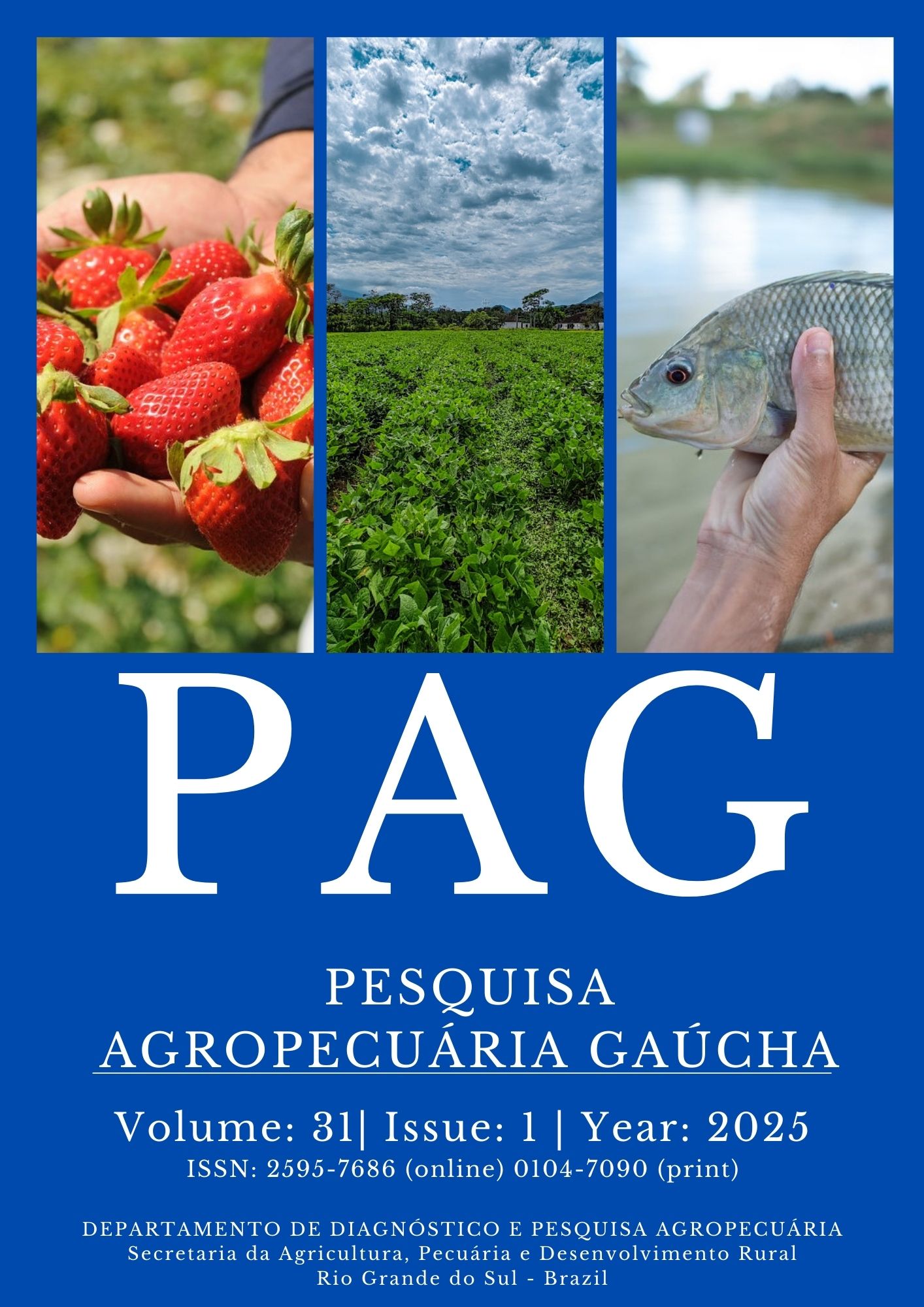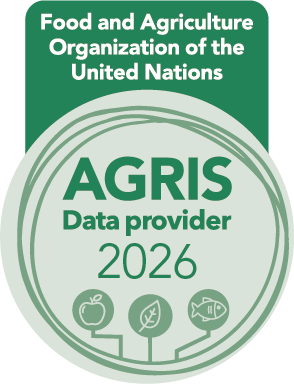Digestibilidade aparente da farinha de folhas da Ora-pro-nóbis (Pereskia aculeata) para tilápia-do-nilo (Oreochromis niloticus)
DOI:
https://doi.org/10.36812/pag.20253111-13Palavras-chave:
alimentação alternativa, nutrição de peixes, criação de tilápia, alimentação não convencional, alimentação vegetalResumo
O objetivo deste estudo foi determinar a digestibilidade aparente da farinha de folhas de ora-pro-nóbis (FFO) para tilápia-do-nilo, avaliando proteína bruta (PB), aminoácidos (AA), energia bruta (EB), extrato etéreo (EE) e matéria seca (MS). Utilizou-se o método indireto com óxido crômico e coleta de fezes por sedimentação. Foram preparados dois alimentos, um aplicado a uma dieta referência e outro a uma dieta teste, sendo esta última composta por 30,0 % de FFO e 70,0 % da dieta referência. Os coeficientes de digestibilidade aparente (CDA) da FFO foram 30,01 % (MS), 40,60 % (EB), 76,86 % (EE) e 45,51 % (PB). Entre os AA essenciais, o triptofano (98,00 %) e a leucina (80,00 %) tiveram os maiores valores, enquanto a treonina (25,00 %) e a arginina (39,00 %) apresentaram os menores. Apesar da baixa digestibilidade da proteína e energia, a FFO forneceu quantidades significativas de aminoácidos essenciais absorvidos pelos peixes. Assim, pode ser utilizada como ingrediente complementar em dietas para tilápia-do-nilo, mas não como principal fonte proteica ou energética.
Downloads
Referências
ABO-STATE, H. et al. Evaluation of feeding raw moringa (Moringa oleifera Lam.) leaves meal in Nile tilapia fingerlings (Oreochromis niloticus) diets. Global Veterinaria, v. 13, n. 1, p. 105–111, 2014.
ALFIKO, Y. et al. Insects as a feed ingredient for fish culture: Status and trends. Aquaculture and Fisheries, v. 7, n. 2, p. 166–178, 2022. https://doi.org/10.1016/j.aaf.2021.10.004. DOI: https://doi.org/10.1016/j.aaf.2021.10.004
ALMEIDA, M. E. F. et al. Chemical characterization of the non-conventional vegetable known as ora-pro-nóbis. Bioscience Journal, Uberlândia, v. 30, p. 431–439, 2014. Available from: https://seer.ufu.br/index.php/biosciencejournal/article/view/17555. Accessed: Feb. 6, 2025.
ALMEIDA FILHO, J.; CAMBRAIA, J. Estudo do valor nutritivo de ora-pro-nobis (Pereskia aculeata Mill.). Revista Ceres, Viçosa, v. 21, n. 114, p. 105–111, 1974.
AOAC INTERNATIONAL; LATIMER JUNIOR, G. W. (ed.). Official Methods of Analysis. 21. ed. AOAC International, 2019. v. 1.
ARAÚJO, J. R. et al. Apparent digestibility of ingredients of the Northeast Semi-Arid for Nile tilapia. Ciência Rural, Santa Maria, v. 42, n. 5, p. 900–903, 2012. https://doi.org/10.1590/S0103-84782012000500023. DOI: https://doi.org/10.1590/S0103-84782012000500023
ASSOCIAÇÃO BRASILEIRA DA PISCICULTURA. Anuário PEIXE BR da Piscicultura. 8. ed. São Paulo: PEIXE BR, 2024. Available from: https://www.peixebr.com.br/anuario-2024. Accessed: Feb. 6, 2025.
ASSOCIAÇÃO NACIONAL DOS FABRICANTES DE RAÇÕES. Compêndio Brasileiro de Alimentação Animal: Métodos Analíticos. São Paulo: Sindirações, 2017.
BABALOLA, O. A.; FAKUNMOJU, F. A. Effect of partial replacement of fishmeal with Leucaena leucocephala leaf meal on the growth performance of Tilapia zilli fingerlings. Asian Journal of Fisheries and Aquatic Research, v. 9, n. 2, p. 9–14, 2020. https://doi.org/10.9734/ajfar/2020/v9i230154. DOI: https://doi.org/10.9734/ajfar/2020/v9i230154
BIUDES, J. F. V.; PEZZATO, L. E.; CAMARGO, A. F. M. Apparent digestibility of water hyacinth meal by Nile tilapia. Revista Brasileira de Zootecnia, v. 38, n. 11, p. 2079–2085, 2009. https://doi.org/10.1590/S1516-35982009001100001. DOI: https://doi.org/10.1590/S1516-35982009001100001
BOTREL, N. et al. Comparative study of protein composition and amino acid profile in five pereskia clones. Brasília, DF: Embrapa Hortaliças, 2019. (Embrapa Hortaliças. Boletim de pesquisa e desenvolvimento, 196). Available from: https://www.infoteca.cnptia.embrapa.br/infoteca/bitstream/doc/1112949/1/BPD196291020192b1.pdf. Accessed: Feb. 6, 2025.
BUREAU, D. P.; HARRIS, A. M.; CHO, C. Y. Apparent digestibility of rendered animal protein ingredients for rainbow trout (Oncorhynchus mykiss). Aquaculture, v. 180, n. 3–4, p. 345–358, 1999. https://doi.org/10.1016/S0044-8486(99)00210-0. DOI: https://doi.org/10.1016/S0044-8486(99)00210-0
CAMPOS-RAMOS, R. et al. An investigation of sex determination in the Mozambique tilapia, Oreochromis mossambicus, using synaptonemal complex analysis, FISH, sex reversal and gynogenesis. Aquaculture, v. 221, n. 1–4, p. 125–140, 2003. https://doi.org/10.1016/S0044-8486(03)00072-3. DOI: https://doi.org/10.1016/S0044-8486(03)00072-3
CHEN, S. et al. Effect of Moringa oleifera leaf meal supplementation on growth performance, morphological indexes, antioxidant status and resistance to Streptococcus agalactiae of Nile tilapia (Oreochromis niloticus). Turkish Journal of Fisheries and Aquatic Sciences, v. 21, n. 1, p. 29–39, 2020. http://doi.org/10.4194/1303-2712-v21_1_04. DOI: https://doi.org/10.4194/1303-2712-v21_1_04
CHEN, Y. et al. Evaluation of pigeon pea leaves (Cajanus cajan) replacing alfalfa meal on growth performance, carcass trait, nutrient digestibility, antioxidant capacity and biochemical parameters of rabbits. Journal of Animal Physiology and Animal Nutrition, v. 103, n. 5, p. 1265–1273, 2019. https://doi.org/10.1111/jpn.13119. DOI: https://doi.org/10.1111/jpn.13119
CHO, C. Y.; SLINGER, S. J.; BAYLEY, H. S. Bioenergetics of salmonid fishes: Energy intake, expenditure and productivity. Comparative Biochemistry and Physiology, v. 73B, n. 1, p. 25–41, 1982. https://doi.org/10.1016/0305-0491(82)90198-5. DOI: https://doi.org/10.1016/0305-0491(82)90198-5
DIAS, P. S. et al. Energy and nutrient digestibility from mulberry (Morus alba) leaf meal for Nile tilapia. Acta Scientiarum. Animal Sciences, v. 44, p. 1–6, 2022a. https://doi.org/10.4025/actascianimsci.v44i1.54443. DOI: https://doi.org/10.4025/actascianimsci.v44i1.54443
DIAS, P. S. et al. Mulberry leaf meal (Morus alba) on the performance of Nile tilapia (Oreochromis niloticus) in growth. Concilium, v. 22, n. 3, p. 507–519, 2022b. DOI: https://doi.org/10.53660/CLM-266-269
HLOPHE, S.; MOYO, N. Evaluation of kikuyu grass and moringa leaves as protein sources in Oreochromis mossambicus diets. African Journal of Aquatic Science, v. 39, n. 3, p. 305–312, 2014. https://doi.org/10.2989/16085914.2014.958049. DOI: https://doi.org/10.2989/16085914.2014.958049
JHA, R.; BERROCOSO, J. D. Review: Dietary fiber utilization and its effects on physiological functions and gut health of swine. Animal, v. 9, n. 9, p. 1441–1452, 2015. https://doi.org/10.1017/S1751731115000919. DOI: https://doi.org/10.1017/S1751731115000919
KIMURA, F. T.; MILLER, V. L. Improved determination of chromic oxide in cal feed and feces. Journal of Agricultural and Food Chemistry, v. 5, n. 3, p. 216, 1957. https://doi.org/10.1021/jf60073a008. DOI: https://doi.org/10.1021/jf60073a008
MADALLA, N.; AGBO, N. W.; JAUNCEY, K. Evaluation of aqueous extracted moringa leaf meal as a protein source for Nile tilapia juveniles. Tanzania Journal of Agricultural Sciences, v. 12, n. 1, p. 53–64, 2013. Available from: https://www.ajol.info/index.php/tjags/article/view/102021. Accessed: Feb. 6, 2025.
MADEIRA, N. R. et al. Pereskia elite clones yield under dense planting with successive harvesting. Brasília, DF: Embrapa Hortaliças, 2022. (Embrapa Hortaliças. Boletim de pesquisa e desenvolvimento, 147). Available from: https://www.infoteca.cnptia.embrapa.br/infoteca/bitstream/doc/1138805/1/BPD-247-vFinal.pdf. Accessed: Feb. 6, 2025.
MAZIA, R. S.; SARTOR, C. F. P. Influence of soil type used in the culture of Pereskia aculeata on protein rates. Saúde e Pesquisa, v. 5, n. 1, p. 59–65, 2012.
MERCÊ, A. L. R. et al. Complexes of arabinogalactan of Pereskia aculeata and Co2+, Cu2+, Mn2+, and Ni2+. Bioresource Technology, v. 76, n. 1, p. 29–37, 2001. https://doi.org/10.1016/S0960-8524(00)00078-X. DOI: https://doi.org/10.1016/S0960-8524(00)00078-X
MEURER, F.; HAYASHI, C.; BOSCOLO, W. R. Crude Fiber for Nile tilapia (Oreochromis niloticus, L) Fingerlings. Revista Brasileira de Zootecnia, v. 32, n. 2, p. 256–261, 2003a. https://doi.org/10.1590/S1516-35982003000200002. DOI: https://doi.org/10.1590/S1516-35982003000200002
MEURER, F.; HAYASHI, C.; BOSCOLO, W. R. Apparent Digestibility of Some Protein Sources for Nile Tilapia (Oreochromis niloticus). Revista Brasileira de Zootecnia, v. 32, n. 6, p. 1801–1809, 2003b. https://doi.org/10.1590/S1516-35982003000800001. DOI: https://doi.org/10.1590/S1516-35982003000800001
NATIONAL RESEARCH COUNCIL. Nutrient Requirements of Fish and Shrimp. Washington, DC: The National Academies Press, 2011. https://doi.org/10.17226/13039. DOI: https://doi.org/10.17226/13039
NEW, M. B. What feeds can I use on my farm? In: NEW, M. B. Feed and Feeding of Fish and Shrimp: a manual on the preparation and presentation of compound feeds for shrimp and fish in aquaculture. Rome: United Nations Development Programme: Food and Agriculture Organization of the United Nations, 1987. Available from: https://www.fao.org/4/S4314E/s4314e05.htm. Accessed: Feb. 6, 2025.
OLIVEIRA, D. C.S. et al. Mineral composition and ascorbic acid content in four non-conventional leafy vegetables species. Horticultura Brasileira, v. 31, n. 3, p. 472–475, 2013. https://doi.org/10.1590/S0102-05362013000300021. DOI: https://doi.org/10.1590/S0102-05362013000300021
PANAIN, A. L. et al. Aspectos da produção e da pós-colheita de ora-pro-nóbis. Rio de Janeiro: Neapro-Rio, 2021. Available from: https://institucional.ufrrj.br/agroecologia/files/2019/05/CARTILHA-ORA-PRO-NOBIS-UFRRJ.pdf. Accessed: Feb. 6, 2025.
PINTO, N. C. C. et al. Preclinical studies indicate that INFLATIV, an herbal medicine cream containing Pereskia aculeata, presents potential to be marketed as a topical anti-inflammatory agent and as adjuvant in psoriasis therapy. Journal of Pharmacy and Pharmacology, v. 72, n. 12, p. 1933–1945, 2020. https://doi.org/10.1111/jphp.13357. DOI: https://doi.org/10.1111/jphp.13357
POTTY, V. H. Physio-chemical aspects, physiological functions, nutritional importance and technological significance of dietary fibers - a critical appraisal. Journal of Food Science and Technology, v. 33, n. 1, p. 1–18, 1996.
RIBEIRO JUNIOR, W. A. et al. Propagation of ora-pro-nobis (Cactaceae) from cuttings at different concentrations of IBA. Revista Agro@mbiente, v. 15, p. 1–15, 2021. http://dx.doi.org/10.18227/1982-8470ragro.v15i0.6826. DOI: https://doi.org/10.18227/1982-8470ragro.v15i0.6826
RODRIGUES, A. P. O.; BERGAMIN, G. T.; SANTOS, V. R. V. dos. Nutrição e alimentação de peixes. In: EMBRAPA. Piscicultura de água doce: multiplicando conhecimentos. Brasília, DF: Embrapa, 2013. cap. 6, p. 171–213.
SAENTHAWEESUK, S. Effect of dietary supplementation of mulberry (Morus alba L.) leaf powder in place of antibiotic in feed ration to improve growth performance, meat quality and production of broiler chicken. Journal of Science and Technology Mahasarakham University, v. 28, n. 3, p. 285–290, 2009.
SIMONETTI, M. G.; FARIÑA, L. O; SIMONETTI, K. T. G. The potential of the ora-pro-nóbis (Pereskia aculeata Mill.) in the National School Feeding Program. Research, Society and Development, v. 10, n. 14, p. 1–11, 2021. https://doi.org/10.33448/rsd-v10i14.20381. DOI: https://doi.org/10.33448/rsd-v10i14.20381
SOMMER, M. C.; RIBEIRO, P. F. A.; KAMINSKI, T. A. Obtention and physicochemical characterization of ora-pro-nóbis flour. Brazilian Journal of Health Review, Curitiba, v. 5, n. 2, p. 6878–6892, 2022. https://doi.org/10.34119/bjhrv5n2-256. DOI: https://doi.org/10.34119/bjhrv5n2-256
SOUSA, R. M. F. et al. Antioxidant activity of ora-pro-nóbis (Pereskia aculeata Mill.) leaves extracts using spectrophotometric and voltammetric assays in vitro. Bioscience Journal, Uberlândia, v. 30, p. 448–457, 2014. Available from: https://seer.ufu.br/index.php/biosciencejournal/article/view/19618. Accessed: Feb. 6, 2025.
SOUZA, M. R. M. et al. Mineral, protein and nitrate contents in leaves of Pereskia aculeata subjected to nitrogen fertilization. Pesquisa Agropecuária Tropical, Goiânia, v. 46, n. 1, p. 43–50, 2016. http://dx.doi.org/10.1590/1983-40632016v4637959. DOI: https://doi.org/10.1590/1983-40632016v4637959
TAKEITI, C. Y. et al. Nutritive evaluation of non-conventional leafy vegetable (Pereskia aculeata Miller). International Journal of Food Sciences and Nutrition, v. 60, p. 148–160, 2009. https://doi.org/10.1080/09637480802534509. DOI: https://doi.org/10.1080/09637480802534509
VAN SOEST, P. J.; ROBERTSON, J. B.; LEWIS, B. A. Methods for dietary fiber, neutral detergent fiber, and nonstarch polysaccharides in relation to animal nutrition. Journal of Dairy Science, v. 74, n. 10, p. 3583–3597, 1991. https://doi.org/10.3168/jds.S0022-0302(91)78551-2. DOI: https://doi.org/10.3168/jds.S0022-0302(91)78551-2
Downloads
Publicado
Como Citar
Edição
Seção
Licença
Os autores declaram que o trabalho não foi publicado anteriormente, nem enviado simultaneamente para publicação em outro periódico e que concordam com a submissão, conteúdo e transferência dos direitos de publicação do artigo em questão para o periódico científico Pesquisa Agropecuária Gaúcha - PAG. Os autores assumem total responsabilidade pela originalidade do artigo, podendo incidir sobre os mesmos, eventuais encargos decorrentes de reivindicação, por parte de terceiros, em relação à autoria do artigo.
A reprodução total dos artigos da Revista em outros meios de comunicação eletrônicos de uso livre é permitida de acordo com a licença Creative Commons Atribuição-NãoComercial-CompartilhaIgual 4.0 Internacional.























